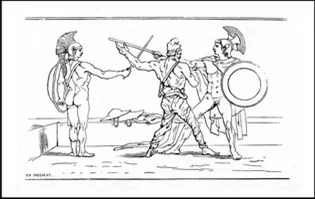Fencing History
Brief history of a technique, of a science, an art, a sport and (or) a method of education
Whether we consider fencing as an art of enjoyment or as a science of arms, a method of education or a sport, its wealth emerges from its study. Wealth of a thousand-year-old history, of a large technical skill and a laudatory record of achievements, wealth of champions and masters who force the respect, and above all wealth of values that fencing knew how to generate and that it still tries to inculcate today through its practice.
The history of this sport is very eloquent, it often relates that of humankind through that of the sword and, if we analyse the feature of the art of weapons, we immediately notice that it corresponds to the customs of the era in which it appears. The human being has always tried to invent weapons to defend himself against the nature and other human beings, and this since Caïn: he used his strength, resorted to his material, improved his dexterity and used his intelligence. The history of fencing gives a marvellous account of all that.

The Pharaohs invent the mask and the competition
Four centuries before the Olympic Games of Antique Greece, a bas-relief in the temple of Medinet-About in High Egypt and built by Ramsès III in 1190 BC, depicts a sporting competition organised by the Pharaoh to celebrate his victory over the Libyans. The weapons - certainly sticks with bronze plates in the end - are buttoned. Hands are protected by a guard similar to that of sabre, and some of the fencers have the face protected by a mask, whose chin rolling pad, covering both ears, is attached to the wig. The non-sword arm is used for parrying blows and is protected by a kind of shield.
The translation of hieroglyphs teaches us that the opponents shouted at each other « On guard … and admire what my valiant hand is going to make! », and that spectators did not spare encouragements for their favourites: « Go ! O excellent fighter! ». The winner salutes with his weapon and hand the Pharaoh who is accompanied by his suite. The public is composed of Assyrians, Libyans and Egyptians; the jury and the organisers are recognizable thanks to their feather. A scribe notes on a papyrus the results of the competition.
The Games of the Olympe
It is necessary to cross ages and transport ourselves in Greece to find in the hoplomachie (fight with weapons one to one) the tracks of a competition where prizes were proposed to the winners...


International Fencing Federation
Founded in 1913 at the initiative of René Lacroix in the lounges of the Automobile Club of France, the FIE was created to standardize rules and organize international competitions...

The signalisation of hits
At the end of the XIX th century, we still rely on the « word of honour » of fencers to count the hits. Then appeared the famous push button, which were welded at the end of the epee and partially recovered with a sticky thread. The remaining point had to hang to the jacket of the opponent but without crossing it … what often happened. At the beginning of the 20s, the novelist Léon Sazie invented the push button at three branches, which was used for a long time in schools because it was practical and harmless.
Other inventions appeared to disappear immediately, following the example of stamping or detonating buttons. We imagined even to fence bare-chested, with the push button. This going back to the stop hit « to the first blood » gave concerns to more than one and worried the others. A big progress was then made by Paul Souzy with his « record player epee », composed of a box, a body wire and an epee. It signalised the hits with a battery-operated snorer and an electric light bulb, and marked in cochineal the place of the impact. We know the continuation : the electric apparatus of signalisation of hits was adopted by the federation in 1936.
Historical achieved by Master Gérard Six